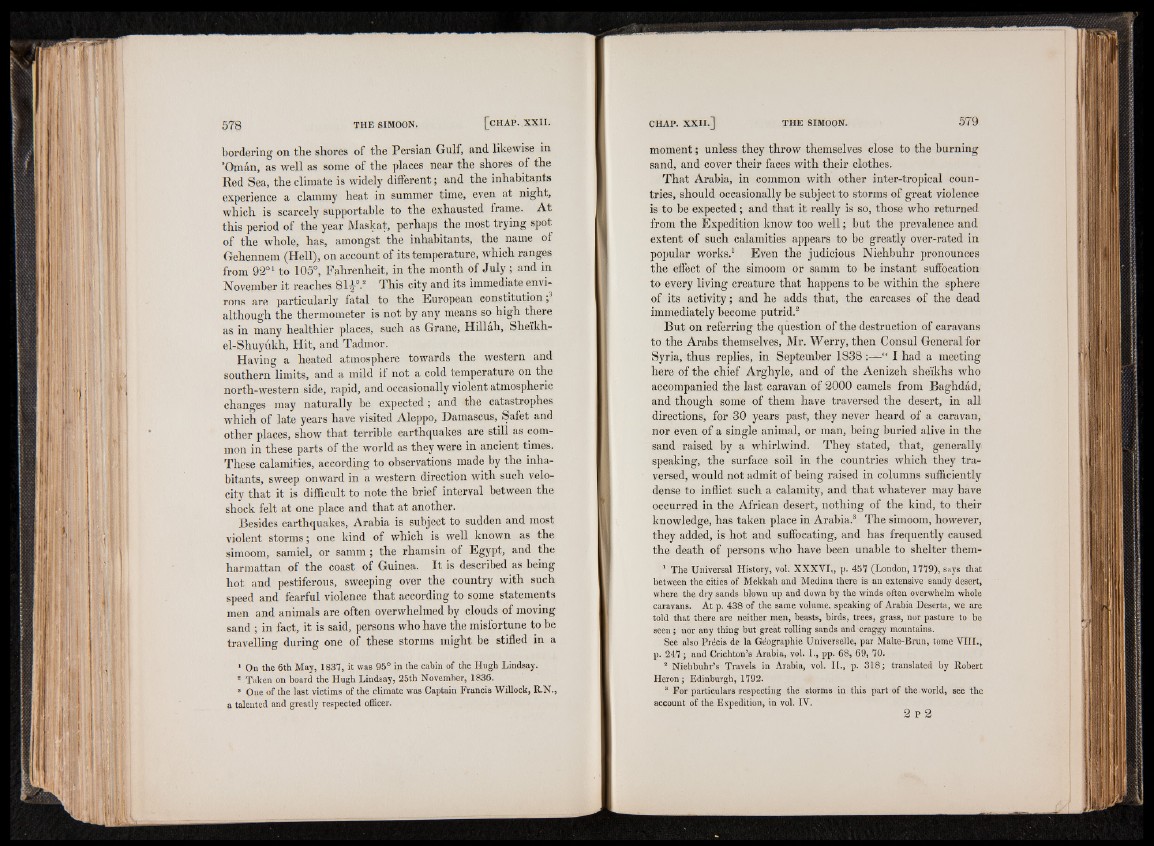
bordering on the shores of the Persian Gulf, and likewise in
’Oman, as well as some of the places near the shores of the
Red Sea, the climate is widely different; and the inhabitants
experience a clammy heat in summer time, even at night,
which is scarcely supportable to the exhausted frame. At
this period of the year Maskat, perhaps the most trying spot
of the whole, has, amongst the inhabitants, the name of
Gehennem (Hell), on account of its temperature, which ranges
from 9201 to 105°, Fahrenheit, in the month of July; and in
November it reaches 81-^°.2 This city and its immediate environs
are particularly fatal to the European constitution ;3
although the thermometer is not by any means so high there
as in many healthier places, such as Grane, Hillah, Shei’kh-
el-Shuyukh, Hit, and Tadmor.
Having a heated atmosphere towards the western and
southern limits, and a mild if not a cold temperature on the
north-western side, rapid, and occasionally violent atmospheric
changes may naturally be expected; and the catastrophes
which of late years have visited Aleppo, Damascus, Safet and
other places, show that terrible earthquakes are still as common
in these parts of the world as they were in ancient times.
These calamities, according to observations made by the inhabitants,
sweep onward in a western direction with such velocity
that it is difficult to note the brief interval between the
shock felt at one place and that at another.
Besides earthquakes, Arabia is subject to sudden and most
violent storms; one kind of which is well known as the
simoom, samiel, or samm ; the rhamsin of Egypt, and the
harmattan of the coast of Guinea. It is described as being
hot and pestiferous, sweeping over the country with such
speed and fearful violence that according to some statements
men and animals are often overwhelmed by clouds of moving
sand ; in fact, it is said, persons who have the misfortune to be
travelling during one of these storms might be stifled in a
1 On the 6th May, 1837, it was 95° in the cabin of the Hugh Lindsay.
a Taken on board the Hugh Lindsay, 25th November, 1836.
3 One of the last victims of the climate was Captain Francis Willock, R.N.,
a talented and greatly respected officer.
moment; unless they throw themselves close to the burning
sand, and cover their faces with their clothes.
That Arabia, in common with other inter-tropical countries,
should occasionally be subject to storms of great violence
is to be expected; and that it really is so, those who returned
from the Expedition know too well; but the prevalence and
extent of such calamities appears to be greatly over-rated in
popular works.1 Even the judicious Niehbuhr pronounces
the effect of the simoom or samm to be instant suffocation
to every living creature that happens to be within the sphere
of its activity; and he adds that, the carcases of the dead
immediately become putrid.2
But on referring the question of the destruction of caravans
to the Arabs themselves, Mr. Werry, then Consul General for
Syria, thus replies, in September 1838 :—“ I had a meeting
here of the chief Arghyle, and of the Aenizeh sheikhs who
accompanied the last caravan of 2000 camels from Baghdad,
and though some of them have traversed the desert, in all
directions, for 30 years past, they never heard of a caravan,
nor even of a single animal, or man, being buried alive in the
sand raised by a whirlwind. They stated, that, generally
speaking, the surface soil in the countries which they traversed,
would not admit of being raised in columns sufficiently
dense to inflict such a calamity, and that whatever may have
occurred in the African desert, nothing of the kind, to their
knowledge, has taken place in Arabia.3 The simoom, however,
they added, is hot and suffocating, and has frequently caused
the death of persons who have been unable to shelter them-
* The Universal History, vol; XXXVI,) P- 457 (London, 1779), says that
between the cities of Mekkah and Medina there is an extensive sandy desert,
where the dry sands blown up and down by the winds often overwhelm whole
caravans. At p. 438 of the same volume, speaking of Arabia Deserta, we are
told that there are neither men, beasts, birds, trees, grass, nor pasture to be
seen; nor any thing hut great rolling sands and craggy mountains.
See also Precis de la Gdographie Universelle, par Malte-Brun, tome VIII.,
p. 247; and Crichton’s Arabia, vol. I., pp. 68, 69, 70.
! Niehbuhr’s Travels in Arabia, vol. II., p. 318; translated by Robert
Heron; Edinburgh, 1792.
“ For particulars respecting the storms in this part of the world, see the
account of the Expedition, in vol. IV.